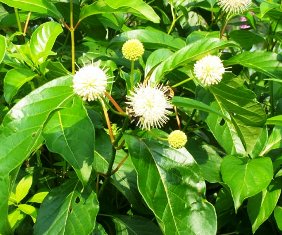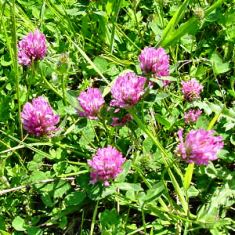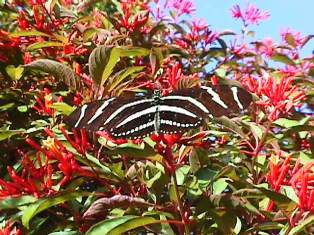Discover Florida Nature
It's time to explore the natural Florida


|
|
|
|
|
Browse through our alphabetical list of native Florida plants that
encourage butterflies into your garden, and find the perfect choices for
your Florida butterfly garden! Plants that have an asterisk beside their
name are especially high in nectar. Buttonbush
(Cephalanthus occidentalis)*- Buttonbush is a woody shrub, 3-10
feet tall, that occasionally grows into a small tree. It has shiny
dark-green spear-or egg-shaped pointed leaves 3 to 6 inches long. The
leaves are opposite or whorled in 3's or 4's along the stem. Flowers of
buttonbush are easily identified by their greenish-white tube flowers in
dense ball-shaped clusters about 1 inch in diameter. The long-lasting,
unusual blossoms are white or pale-pink, one-inch globes. Subsequent
rounded masses of nutlets persist through the winter. Seed heads are
brown. Buttonbush is a handsome ornamental suited to wet soils and is
also a honey plant.
Ducks and other water birds and
shorebirds consume the seeds. in it's native Florida environment,
the buttonbush may be found in swamps,
around ponds and margins of streams throughout the state. Buttonbush
grows well in sand, loam, clay, limestone, and moist, poor drainage or
standing water is okay with this butterfly attracting plant. Buttonbush
(Cephalanthus occidentalis)*- Buttonbush is a woody shrub, 3-10
feet tall, that occasionally grows into a small tree. It has shiny
dark-green spear-or egg-shaped pointed leaves 3 to 6 inches long. The
leaves are opposite or whorled in 3's or 4's along the stem. Flowers of
buttonbush are easily identified by their greenish-white tube flowers in
dense ball-shaped clusters about 1 inch in diameter. The long-lasting,
unusual blossoms are white or pale-pink, one-inch globes. Subsequent
rounded masses of nutlets persist through the winter. Seed heads are
brown. Buttonbush is a handsome ornamental suited to wet soils and is
also a honey plant.
Ducks and other water birds and
shorebirds consume the seeds. in it's native Florida environment,
the buttonbush may be found in swamps,
around ponds and margins of streams throughout the state. Buttonbush
grows well in sand, loam, clay, limestone, and moist, poor drainage or
standing water is okay with this butterfly attracting plant.  Clover
(Trifolium spp)- Clovers, depending on species, may be annuals or
perennials. Typically, clovers are fairly low-growing, herbaceous
plants. The leaves are divided into three leaflets which are attached to
the petiole at or near the same point. Blossoms usually occur in
ball-like clusters (sometimes in clusters of just a few flowers) and may
be pink, red, white, or yellow, depending on the clover species. In
lawns, clovers can form dense patches, crowding out turfgrasses. They do
not withstand traffic well. Clovers can also be desirable plants in
lawns due to their nitrogen-fixing ability. Increases in clover may
indicate soils are low in nitrogen. Bees and butterflies are attracted
to the clover blossom. Clovers commonly grow in fields, meadows, and
other sites on well-drained soils. They may be included in seed mixes
for lawns, but are sometimes considered to be lawn weeds. Some species
of adult butterflies which visit Red Clover flowers include:
Monarch,
Eastern Black Swallowtail,
Painted Lady, and
Red Admiral. Clover
(Trifolium spp)- Clovers, depending on species, may be annuals or
perennials. Typically, clovers are fairly low-growing, herbaceous
plants. The leaves are divided into three leaflets which are attached to
the petiole at or near the same point. Blossoms usually occur in
ball-like clusters (sometimes in clusters of just a few flowers) and may
be pink, red, white, or yellow, depending on the clover species. In
lawns, clovers can form dense patches, crowding out turfgrasses. They do
not withstand traffic well. Clovers can also be desirable plants in
lawns due to their nitrogen-fixing ability. Increases in clover may
indicate soils are low in nitrogen. Bees and butterflies are attracted
to the clover blossom. Clovers commonly grow in fields, meadows, and
other sites on well-drained soils. They may be included in seed mixes
for lawns, but are sometimes considered to be lawn weeds. Some species
of adult butterflies which visit Red Clover flowers include:
Monarch,
Eastern Black Swallowtail,
Painted Lady, and
Red Admiral. Firebush (Hamelia
patens)- Firebush...the name says it all! This tropical shrub is known
for two attributes. First, the plant shows colors that would make any
blaze proud. And second, it's the only plant that I know which actually
performs better the closer it gets to spontaneous combustion! Firebush
is a showy, fast-growing, semi-woody evergreen shrub that can get up to
15 feet tall under ideal conditions, but usually stays much smaller. It
has whorled leaves, usually with three but occasionally as many as seven
at each node. The firebush hails from South Florida, the West Indies,
and Central and South America. In its native habitat, Firebush is known
more for its herbal properties than for its ornamental value. Throughout
the year, firebush produces showy terminal clusters (cymes) of bright
reddish-orange or scarlet tubular flowers. Firebush is a valuable
addition to butterfly and
hummingbird gardens,
and in south Florida is often planted in wildlife gardens with other
native shrubs such as American
beautyberry, coral bean and
wild coffee. Firebush is salt tolerant and will grow in any kind of
soil as long as it is well drained. Firebush (Hamelia
patens)- Firebush...the name says it all! This tropical shrub is known
for two attributes. First, the plant shows colors that would make any
blaze proud. And second, it's the only plant that I know which actually
performs better the closer it gets to spontaneous combustion! Firebush
is a showy, fast-growing, semi-woody evergreen shrub that can get up to
15 feet tall under ideal conditions, but usually stays much smaller. It
has whorled leaves, usually with three but occasionally as many as seven
at each node. The firebush hails from South Florida, the West Indies,
and Central and South America. In its native habitat, Firebush is known
more for its herbal properties than for its ornamental value. Throughout
the year, firebush produces showy terminal clusters (cymes) of bright
reddish-orange or scarlet tubular flowers. Firebush is a valuable
addition to butterfly and
hummingbird gardens,
and in south Florida is often planted in wildlife gardens with other
native shrubs such as American
beautyberry, coral bean and
wild coffee. Firebush is salt tolerant and will grow in any kind of
soil as long as it is well drained.
|
|
|
Advertise | Privacy Statement | Contact | Alaska Nature | Michael Arnold Art| Dog Encyclopedia | Dog Encyclopedia| |
|